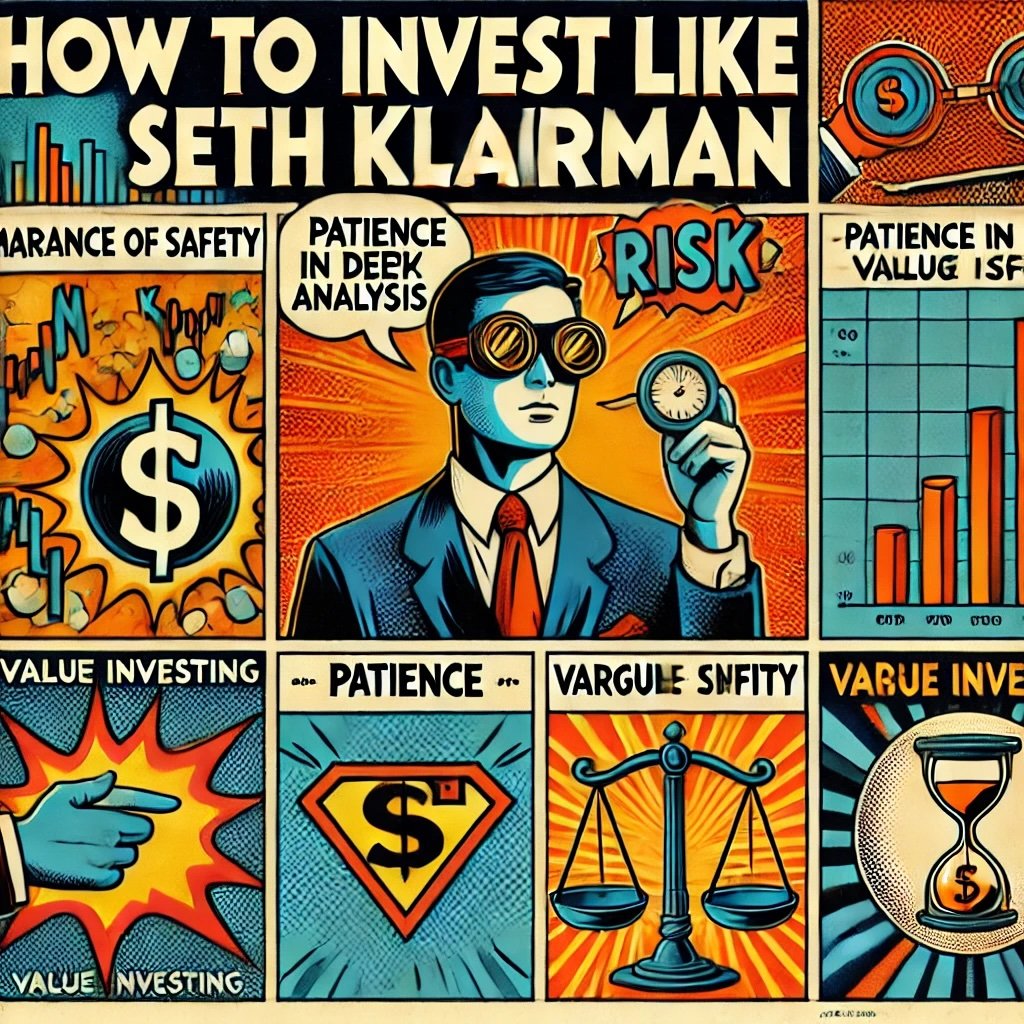An embodiment of shrewd acumen and judicious perspicacity, Joel Greenblatt’s name has become synonymous with value investing. Born in 1957, Greenblatt cut his teeth on the challenging terrains of Wall Street and blossomed into one of the most respected figures in the financial sector. He graduated from the Wharton School of the University of Pennsylvania, armed with an MBA and an insatiable appetite for exploring the labyrinthine intricacies of the stock market.

Joel Greenblatt: A Portrait of A Prudent Pragmatist

In 1985, Greenblatt demonstrated his entrepreneurial prowess by founding Gotham Capital, a private investment firm. Under his stewardship, the company grew exponentially, marking an annual return of 50% from its inception to 2005. His success emanated not from sheer serendipity but rather from an unflinching commitment to a novel investment philosophy he had honed over time. Greenblatt’s published works, such as “The Little Book That Beats the Market” and “You Can Be a Stock Market Genius,” encapsulate his financial wisdom and serve as valuable guides for those navigating the choppy waters of investing.
source: The Investor’s Podcast Network on YouTube
Unraveling the Greenblatt Investment Philosophy
The cornerstone of Greenblatt’s investment philosophy rests on a straightforward yet profound premise: purchase well-established, high-return businesses when their stock prices are undervalued. Eschewing the capricious tendencies of speculators who seek to profit from ephemeral market fluctuations, Greenblatt stands firmly in the camp of value investing, a disciplined approach championed by luminaries such as Benjamin Graham and Warren Buffett.
Value investing, however, is not monolithic, and Greenblatt’s unique contribution to its evolution is the nuanced emphasis he places on the Return on Invested Capital (ROIC). Unlike traditional metrics, ROIC offers a more comprehensive insight into a company’s operational efficiency and potential profitability by measuring the returns that a company generates on the capital invested in it.
Yet, this is not all. Greenblatt ingeniously complements this measure with a calculation of the earnings yield of a company. The intricate interplay of these two metrics – ROIC and earnings yield – constitutes the heart of Greenblatt’s “magic formula.” By systematizing the process of identifying undervalued yet high-performing companies, the formula serves as a compass guiding investors through the often nebulous realms of the stock market.
Despite its apparent simplicity, Greenblatt’s philosophy calls for astute discernment, rigorous analysis, and disciplined patience. It underscores the importance of marrying quantitative analysis with a qualitative understanding of a company’s long-term value proposition. In the following sections, we shall delve deeper into the mechanism of Greenblatt’s ROIC approach, demonstrating its enduring relevance in the dynamic landscape of value investing.
source: Corporate Finance Institute on YouTube

Understanding ROIC (Return on Invested Capital)
Defining ROIC: The Keystone Metric
Return on Invested Capital, often abbreviated as ROIC, is a fundamental metric that offers a panoramic perspective of a company’s financial performance. It manifests the efficiency with which a company utilizes its invested capital to generate profit. The invested capital encompasses both equity and debt, portraying a holistic picture of a firm’s operational efficacy.
This metric is derived by juxtaposing a company’s net operating profit after tax (NOPAT) against the capital invested in its operations. ROIC hence bridges the gap between a company’s operational performance and its financial structure, offering an integrated understanding that many conventional financial ratios often fail to deliver.
The Primacy of ROIC in Investment Decisions
The role of ROIC in shaping investment decisions is second to none. It allows investors to penetrate beneath the superficial layers of revenue and profit figures and assess a company’s intrinsic ability to generate wealth from its investments. Companies with a high ROIC are usually adept at deploying capital judiciously, leading to more substantial, sustainable returns in the long run.
Investors employing ROIC as a navigational aid can discern between companies that are thriving due to operational efficiency and those riding the wave of beneficial market conditions or high leverage. ROIC, therefore, empowers the investor to identify genuine value, underpinned by robust operational performance, even in an environment muddled with transient noise.

Calculating ROIC: The Equation of Efficiency
To calculate ROIC, one needs to understand its two main components: Net Operating Profit After Taxes (NOPAT) and Invested Capital.
NOPAT is the profit derived from a company’s core operations after taxes but before interest expenses. It strips away the effects of financial structure and tax management, enabling investors to focus solely on the company’s operational efficiency.
On the other hand, Invested Capital is the total capital deployed by the firm to operate its business. This includes equity (common and preferred shares), long-term debt, capital lease obligations, and short-term debt, minus non-operating assets, including excess cash and non-interest-bearing current liabilities.
The formula for calculating ROIC, therefore, is:
ROIC = NOPAT / Invested Capital
As investors delve into the intricacies of ROIC calculation, they equip themselves with a potent tool to differentiate the proverbial wheat from the chaff, identifying investment opportunities that stand on the solid bedrock of operational excellence rather than the shifting sands of market sentiments.
source: The Investing for Beginners Podcast on YouTube
The Greenblatt ROIC Approach

Greenblatt’s Unique Take on ROIC
Greenblatt’s discernment of ROIC manifests a marked departure from the conventional understanding of the metric. While most investors regard ROIC as a mere cog in the wheel of financial analysis, Greenblatt elevates it to a pivotal role, considering it the linchpin of a company’s value proposition. For Greenblatt, ROIC is not merely a reflection of a firm’s past performance but a reliable harbinger of its future prospects.
This radical reimagining of ROIC stems from Greenblatt’s core conviction that investing is about buying companies instead of trading stocks. A high ROIC, in his estimation, signifies a company with a durable competitive advantage capable of generating healthy profits from its investments. This ‘moat’ shields the firm from competitive forces, ensuring a steady flow of earnings and making it an attractive destination for discerning value investors.
ROIC in Greenblatt’s Investing Strategy
Greenblatt’s strategy distills the complexities of investing into a finely tuned methodology that pivots on ROIC. By focusing on firms that register high ROIC, he identifies those businesses that excel in generating returns from their capital. Such firms, he posits, have honed their strategic and operational mechanisms to a point where they can repeatedly outperform their competitors, implying a degree of stability and resilience.
However, Greenblatt does not stop at identifying high-ROIC firms. He couples this information with the current market price of the firms’ shares, allowing him to pinpoint instances where the market undervalues these superior performers. Thus, ROIC acts as a filter, enabling Greenblatt to sift through the market noise and zero in on genuinely profitable and sustainable investment opportunities.
source: The Swedish Investor on YouTube
The Magic Formula: Marrying ROIC with Earnings Yield
Greenblatt’s “magic formula” stands at the confluence of ROIC and earnings yield, offering investors a streamlined pathway to lucrative investments. The formula ranks companies based on these two parameters, favoring businesses with high ROIC and a high earnings yield – a sign of undervaluation.
The magic formula’s genius lies in its simplicity and objectivity. By automating the process of stock selection, it eliminates emotional biases and ensures a consistent application of value investing principles. In essence, it identifies firms that generate superior returns (as evidenced by high ROIC) and are trading at bargain prices (as indicated by a high earnings yield).
Despite its mechanical nature, the magic formula demands a degree of patience and fortitude from its followers. In certain market conditions, the formula’s picks might underperform, leading to short-term underperformance. However, Greenblatt insists that consistent application of the formula over a long period (typically 3-5 years) yields above-average market returns.
The Greenblatt ROIC approach, as encapsulated in the magic formula, offers a refreshing blend of simplicity, discipline, and robustness, rendering it a potent weapon in the arsenal of any value investor. It embodies the belief that investing, at its core, is about buying pieces of businesses, not trading pieces of paper – a conviction that has guided Greenblatt through his stellar investment career.

Case Study: Successful Application of the Greenblatt ROIC Method
The Application of Greenblatt’s ROIC Approach
A tangible manifestation of Greenblatt’s ROIC approach can be discerned in his investment in Apple Inc. in the early 2000s. At the time, Apple’s iPod was gaining immense popularity, yet the company’s stock was trading at a relatively modest price owing to the broader skepticism around technology stocks following the dot-com bust.
Greenblatt recognized the dichotomy between Apple’s market price and its intrinsic value. His application of the ROIC methodology revealed a company that was efficiently deploying its capital to generate profit. Apple’s ROIC was soaring, fueled by the overwhelming success of the iPod and its contribution to the company’s bottom line. Despite the robust financial performance, the market was yet to fully acknowledge the company’s growth potential, as evidenced by its high earnings yield.
Consequently, Greenblatt, guided by his ROIC approach, chose to invest in Apple. The decision bore fruit as Apple’s stock price skyrocketed in the subsequent years, catalyzed by the launch of the iPhone and the iPad, validating Greenblatt’s assessment of Apple’s intrinsic value.
Decision-Making Process in the Context of Greenblatt’s Principles
Reflecting on the decision-making process, it becomes clear that Greenblatt’s investment in Apple was not a product of serendipity but the deliberate application of his ROIC methodology. The decision was rooted in a meticulous analysis of Apple’s financial performance, particularly its high ROIC, signaling the company’s ability to generate substantial profits from its investments.
Simultaneously, Greenblatt took cognizance of the disparity between the company’s intrinsic value and its market price, as indicated by its high earnings yield. Despite the broader market skepticism towards technology stocks, Greenblatt, trusting his analysis, chose to invest in Apple, exemplifying the courage and conviction that are integral to his investment philosophy.
This case study underscores the elegance and effectiveness of the Greenblatt ROIC approach. By focusing on the core financial fundamentals and isolating the noise of market sentiments, Greenblatt managed to identify a golden investment opportunity. His experience serves as a testament to the potential rewards awaiting investors who can successfully navigate the market’s tumultuous waters using the compass of ROIC.

Criticisms and Limitations of the Greenblatt ROIC Method
A Chorus of Criticism: Counterpoints from Financial Analysts and Investors
Despite the elegance and efficacy of the Greenblatt ROIC method, it has not been immune to criticism. Financial analysts and investors have often voiced concerns, offering counterpoints that invite thoughtful introspection.
One primary contention pertains to the oversimplification that the magic formula is accused of. While its simplicity is indeed its charm, critics argue that this reductionist approach may neglect other crucial aspects of a company’s financial health, such as debt levels, growth potential, industry position, management quality, or evolving market dynamics.
Another criticism targets the mechanical nature of the formula. Critics posit that such an automated approach may lead to a passive investment strategy, neglecting the benefits of active portfolio management. Such a strategy may lack the nimbleness required to respond to sudden market shifts or evolving company fundamentals.
Lastly, the methodology’s emphasis on long-term investment has faced scrutiny. Critics argue that the method’s stipulation of a 3-5 year horizon for yielding results may deter investors seeking quicker returns. Furthermore, the occasional underperformance of the formula’s picks in the short term can test investors’ patience and conviction.
Identifying the Achilles’ Heel: Scenarios Limiting the Greenblatt ROIC Approach
The effectiveness of the Greenblatt ROIC approach, while proven in many scenarios, can wane in certain market conditions or specific sectors. One such scenario is a bull market, especially one characterized by speculative frenzy. In such a market, undervalued companies may remain overlooked, and the high-performing companies identified by the magic formula may underperform relative to overvalued yet popular picks.
Moreover, the Greenblatt method might exhibit limitations when applied to sectors where traditional ROIC calculation proves challenging. For instance, in sectors such as biotechnology or internet services, where the capital structure and investment mechanisms differ significantly from traditional industries, applying the ROIC model might provide skewed insights.
Also, in industries characterized by high levels of disruption and rapid technological advancement, the ROIC model’s emphasis on past performance might not be a reliable indicator of future prospects.
Criticism and limitations notwithstanding, the Greenblatt ROIC method remains a valuable tool in the investor’s arsenal. It requires the investor to possess a discerning eye to recognize its limitations and an adaptable mindset to deploy it judiciously in concert with other financial insights and market understanding.
source: Investor Center on YouTube

The Impact of Greenblatt’s ROIC Method on Modern Value Investing
Greenblatt’s Indelible Influence: Reimagining Value Investing
Joel Greenblatt’s innovative interpretation of ROIC has profoundly reshaped the landscape of value investing. His methodology has breathed fresh life into the field, presenting a novel approach that departs from traditional value investing principles while upholding their fundamental essence.
Before Greenblatt, most value investors focused primarily on book value, earnings multiples, or dividend yield to identify undervalued companies. Greenblatt, however, introduced a shift in perspective by placing ROIC at the heart of his strategy. His emphasis on operational efficiency and the effective deployment of capital offers a more nuanced understanding of a company’s underlying value, as it captures a firm’s ability to generate profits from its investments, which is central to its long-term sustainability.
The introduction of the “magic formula” – a fusion of ROIC and earnings yield – further revolutionized value investing by providing a systematic, objective framework for stock selection. This method has demystified value investing for many, distilling the complex process into an accessible, easy-to-apply strategy.
The Greenblatt Legacy: Enduring Relevance in Today’s Financial Landscape
Despite the evolving financial landscape and the emergence of new investment philosophies, Greenblatt’s ROIC method continues to hold sway. It provides an anchor of stability in the turbulent sea of investing, maintaining its relevance in a world increasingly shaped by algorithmic trading and artificial intelligence.
In an age characterized by information overload, the simplicity and focus of the Greenblatt method offer investors a welcome respite. It allows them to cut through the noise and concentrate on what truly matters: a company’s ability to efficiently generate profits and its current valuation in the market.
Moreover, the ongoing interest in ESG (Environmental, Social, and Governance) investing also highlights the relevance of Greenblatt’s approach. ROIC, by measuring how efficiently a company uses its capital, aligns with the ‘G’ in ESG, as better governed firms tend to deploy capital more efficiently.
Furthermore, as investors increasingly seek sustainable returns in the face of growing economic uncertainties, Greenblatt’s emphasis on a long-term, patient approach to investing resonates more than ever.
Greenblatt’s ROIC method, thus, continues to influence modern value investing significantly. Its enduring relevance is a testament to its robustness, practicality, and, above all, its capacity to help investors identify and capitalize on sustainable value in the market.

How to Apply the Greenblatt ROIC Method in Your Investment Strategy
Laying the Groundwork: A Step-by-Step Guide for Investors
The first step towards implementing the Greenblatt ROIC method involves cultivating a firm understanding of the methodology’s principles. A thorough comprehension of the concepts of ROIC and earnings yield is imperative.
Once these principles are ingrained, investors can move towards the practical application of the method. This process commences with the identification of a pool of potential investment opportunities. Subsequently, each company within this pool needs to be evaluated based on its ROIC and earnings yield.
Calculating ROIC involves dividing a company’s net operating profit after taxes (NOPAT) by its invested capital. This formula encapsulates how effectively a company deploys its capital to generate profits. On the other hand, earnings yield is calculated by dividing a company’s earnings before interest and taxes (EBIT) by its enterprise value. This offers an insight into the company’s earnings relative to its market price.
The next step entails ranking the identified companies based on these two metrics. Companies with a high ROIC and a high earnings yield earn a higher rank. According to Greenblatt’s “magic formula”, investors should favor companies that rank high on both parameters.
After the ranking, the focus shifts to portfolio construction. Typically, Greenblatt advises investing in 20-30 high-ranking companies to achieve adequate diversification and reduce idiosyncratic risk. This portfolio should be rebalanced annually, ensuring it always consists of high-ranking companies.
Navigating the Minefield: Precautions While Applying the Greenblatt ROIC Method
While applying the Greenblatt ROIC method, it is essential to bear in mind the limitations and potential pitfalls. This approach, despite its elegance and effectiveness, is not a silver bullet. Its application must be tempered with a discerning eye and a mindful understanding of its constraints.
Firstly, investors should understand that while the magic formula offers a robust framework for stock selection, it does not substitute for comprehensive due diligence. Additional factors like industry dynamics, company management, and economic conditions should also be considered to build a holistic investment thesis.
Secondly, investors should be prepared for potential short-term underperformance. The method, by design, identifies undervalued companies, which might remain out of favor with the market for some time. Thus, patience and conviction are vital attributes for those applying this approach.
Lastly, while the method simplifies stock selection, it still requires a basic understanding of financial statements and investment concepts. Investors should thus ensure they are equipped with the necessary financial acumen or seek advice from financial advisors before implementing this strategy.
Applying the Greenblatt ROIC method is a journey that requires a strong foundation of understanding, an eye for detail, and a pinch of patience. Armed with these, an investor can navigate the complex world of investing with a clear, objective, and effective roadmap.

Adapting the Greenblatt ROIC Method to Different Market Conditions
Testing the Waters: Greenblatt ROIC Method in a Bullish Market
In a bullish market, optimism and rising prices are the order of the day. However, the application of Greenblatt’s ROIC method in such a market context is not without its nuances. The method is designed to identify undervalued companies that are often overlooked in an effervescent bull market where high-growth, popular stocks tend to take center stage.
Moreover, during bull runs, market prices can often deviate significantly from intrinsic values, a condition Greenblatt’s method may find challenging to navigate. In such conditions, the strategy may underperform relative to the broader market in the short term. However, in the long run, as market euphoria subsides and prices revert towards their intrinsic values, the stocks chosen by the method may begin to outperform.
Steadying the Ship: Evaluating the Strategy’s Effectiveness in a Bearish Market
In a bearish market, the Greenblatt ROIC method comes into its own. Amid falling prices and pessimism, the market often indiscriminately undervalues companies. The method, with its focus on operational efficiency (ROIC) and valuation (earnings yield), can unearth gems that the market, in its myopia, has neglected.
These undervalued companies, being financially robust and operationally efficient, are more likely to weather the storm of a bear market and rebound strongly when market conditions improve. Thus, in a bearish market, the Greenblatt method can offer investors a haven of value amid the surrounding gloom.
Navigating the Seas: Adjustments Needed in Volatile or Stable Markets
In volatile markets, where prices swing wildly, the Greenblatt ROIC method can provide a semblance of stability and objectivity. However, during periods of extreme volatility, the ranking based on ROIC and earnings yield may fluctuate substantially, potentially leading to frequent portfolio changes. To mitigate this, investors may consider lengthening their investment horizon or employing a moving average of ROIC and earnings yield to smooth out short-term fluctuations.
Conversely, in stable, range-bound markets, where prices change little over time, the Greenblatt method, being a long-term strategy, may not generate significant outperformance. In such markets, a more active investment strategy may be required to generate returns. Nonetheless, the method can still help investors identify fundamentally sound companies that are likely to thrive when market conditions change.
Adapting the Greenblatt ROIC method to different market conditions requires a discerning eye and a flexible approach. By understanding the nuances of the method and how it interacts with various market environments, investors can better harness its potential and navigate the market’s ebbs and flows with confidence.

Greenblatt ROIC Method in the Context of Global Investing
Cross-Border Exploration: Greenblatt’s Method Beyond the U.S. Frontier
Applying Greenblatt’s ROIC method beyond the United States and in the realm of global investing, including emerging markets, opens up a world of possibilities. The fundamental principles underpinning the method – the search for efficient, undervalued companies – are universal and can theoretically be applied across different markets.
In emerging economies, where information asymmetry is often more pronounced, Greenblatt’s approach may prove particularly beneficial. The method’s emphasis on operational efficiency and earnings yield could help investors unearth overlooked opportunities in these rapidly developing, high-growth markets.
Moreover, the “magic formula” can potentially serve as a much-needed counterweight to the speculative tendencies often prevalent in these markets. By focusing on concrete financial metrics rather than hype or momentum, investors can sidestep potential market bubbles and concentrate on companies with strong fundamentals and attractive valuations.
Navigating Uncharted Waters: Challenges and Strategies in Different Geographic Contexts
While the Greenblatt method holds promise for global investing, it is not without its challenges. Firstly, differences in financial reporting standards across countries can complicate the calculation of ROIC and earnings yield, making cross-border comparisons tricky. Investors may need to make adjustments to account for these disparities.
Secondly, in many emerging markets, issues like weak corporate governance, currency risks, and political instability can significantly influence a company’s performance. The Greenblatt method, with its primary focus on financial metrics, may not fully capture these risks. Therefore, investors must pair it with a thorough analysis of these contextual factors.
Lastly, the Greenblatt method’s effectiveness is predicated on the assumption that the market will eventually recognize a company’s true value. However, in less efficient or illiquid markets, this reversion to intrinsic value may take longer or may not occur at all.
Adapting the Greenblatt method to different geographic contexts requires a combination of careful adjustment and supplementary analysis. By doing so, investors can tap into the power of the “magic formula”, transcending borders and uncovering value in global markets.

The Greenblatt ROIC Method and ESG Investing
Convergence or Divergence: Compatibility of Greenblatt’s Method with ESG Investing
As investment strategies continue to evolve, there has been an increasing focus on integrating Environmental, Social, and Governance (ESG) factors into decision-making processes. At first glance, Greenblatt’s ROIC method, with its quantitative, financial-focused approach, may seem at odds with the qualitative, broad-ranging considerations of ESG investing.
However, on closer examination, it becomes clear that the two can be complementary. The ‘G’ in ESG aligns closely with the principles of Greenblatt’s method. Governance relates to how a company is managed, and well-governed companies often display operational efficiency, a characteristic captured by Greenblatt’s emphasis on high ROIC.
On the environmental and social fronts, the direct links may be less explicit. However, companies that ignore these factors may face significant financial repercussions in the long term, ranging from regulatory fines to reputational damage. Therefore, a company with high ROIC and strong ESG performance may be better positioned to sustain its performance over time.
Walking the Tightrope: Benefits and Drawbacks of Integrating ESG Factors with the Greenblatt Method
Integrating ESG factors into the Greenblatt method offers several potential benefits. It can provide a more holistic view of a company’s value, capturing not just its financial performance but also its impact on society and the environment. This can help investors identify companies that are not only financially efficient but also responsible and sustainable.
Moreover, ESG integration can serve as a risk management tool. ESG factors often signal potential liabilities that may not be immediately apparent from financial statements but could have significant financial consequences. By considering these factors, investors can potentially avoid companies with hidden risks.
However, integrating ESG factors also presents challenges. Firstly, there is no standard methodology for evaluating ESG performance, leading to potential inconsistencies and subjective judgments. Secondly, focusing on ESG factors may lead investors to overlook financially sound companies that do not perform as well on ESG metrics, potentially limiting investment opportunities.
Balancing the quantitative precision of the Greenblatt method with the qualitative assessments of ESG investing is not a straightforward task. However, with careful thought and discerning judgment, it is possible to harmonize the two, creating a robust investment strategy that marries financial efficiency with social responsibility.

The Greenblatt ROIC Method and Technological Innovation
The Tides of Change: Impact of AI and Technological Advancements on the Greenblatt ROIC Method
The advent of Artificial Intelligence (AI) and the surge in technological advancements have started reshaping the landscape of investment management, raising pertinent questions about their implications on traditional investment methods like Greenblatt’s ROIC approach.
AI’s superior data processing capabilities can potentially enhance the application of the Greenblatt ROIC method. By using machine learning algorithms, investors can automate the process of identifying high ROIC and high earnings yield companies, significantly increasing efficiency and reducing the potential for human error.
However, the rise of AI also brings about challenges. Companies at the forefront of technological innovation often reinvest a significant portion of their earnings into research and development, which may lead to a lower ROIC and earnings yield in the short term. Consequently, these companies may be overlooked by a strictly applied Greenblatt method, even though they may hold significant long-term growth potential.
The New Frontier: Leveraging Technology to Optimize the Greenblatt Method
To harness the power of technology effectively, it is necessary to adapt and refine the traditional Greenblatt approach. Machine learning algorithms can be trained to incorporate additional factors such as market sentiment, industry trends, and even ESG considerations alongside ROIC and earnings yield, thereby expanding the scope of the method.
Moreover, the use of AI-powered sentiment analysis tools can provide insights into public opinion about a company, which can be a valuable adjunct to the quantitative analysis performed by the Greenblatt method. It could provide early warnings of potential issues that could impact a company’s performance.
On the other hand, recognizing the potential blind spots of the method in the face of technological innovation, investors could adjust their calculations to account for R&D expenditure as a form of investment. This could provide a more accurate reflection of the efficiency of companies in technology-heavy industries.
The proliferation of AI and other technological advancements necessitates the adaptation of traditional investment methods. By astutely leveraging these technologies, investors can optimize the Greenblatt method, enhancing its effectiveness in the modern investment landscape.
source: Investor Center on YouTube
Conclusion: Key Takeaways from the Greenblatt ROIC Approach
As we traverse back through the labyrinth of this meticulous investigation, several key insights gleaned from Greenblatt’s ROIC method shine forth. Foremost, the power of this method lies in its elegant simplicity, distilling complex financial metrics into an easily understandable, yet profoundly insightful formula. By combining the examination of a company’s operational efficiency (via ROIC) and its undervaluation (via earnings yield), Greenblatt provides a sturdy compass to navigate the often turbulent seas of the financial markets.
The discussions elucidated the flexibility of the method, demonstrating its applicability across diverse market conditions and its potential integration with other prevailing investment philosophies such as ESG investing. Moreover, the exploration of the method’s evolution in the face of technological advancements underscored its inherent adaptability, proving its relevance in the digital age.

Charting the Course Ahead: The Future of Value Investing and the Role of ROIC
Looking ahead, the fusion of the traditional and the modern forms an intriguing panorama. The advent of technologies like AI is poised to transform the investment landscape, automating and enhancing the application of tried-and-true approaches such as Greenblatt’s. As these technologies mature, the evolution of such strategies will undoubtedly make for a fascinating study.
The future of value investing seems secure, although it will not remain unchanged. The core philosophy – purchasing securities trading less than their intrinsic values – will endure. However, how intrinsic value is defined and measured is likely to evolve, with ESG factors and considerations of innovation and technological proficiency becoming increasingly important.
As for ROIC, its fundamental role in assessing a company’s effectiveness in using capital to generate profits ensures its continued relevance in investment decisions. As markets evolve and new trends emerge, ROIC will remain a sturdy pillar in the edifice of value investing, anchoring analyses with its clear, quantitative insights.
Thus, as we continue our journey through the ever-changing world of investing, Greenblatt’s ROIC method stands as a lighthouse amidst the storm – a beacon of wisdom illuminating the path towards the elusive goal of sustainable value creation.
Important Information
Comprehensive Investment Disclaimer:
All content provided on this website (including but not limited to portfolio ideas, fund analyses, investment strategies, commentary on market conditions, and discussions regarding leverage) is strictly for educational, informational, and illustrative purposes only. The information does not constitute financial, investment, tax, accounting, or legal advice. Opinions, strategies, and ideas presented herein represent personal perspectives, are based on independent research and publicly available information, and do not necessarily reflect the views or official positions of any third-party organizations, institutions, or affiliates.
Investing in financial markets inherently carries substantial risks, including but not limited to market volatility, economic uncertainties, geopolitical developments, and liquidity risks. You must be fully aware that there is always the potential for partial or total loss of your principal investment. Additionally, the use of leverage or leveraged financial products significantly increases risk exposure by amplifying both potential gains and potential losses, and thus is not appropriate or advisable for all investors. Using leverage may result in losing more than your initial invested capital, incurring margin calls, experiencing substantial interest costs, or suffering severe financial distress.
Past performance indicators, including historical data, backtesting results, and hypothetical scenarios, should never be viewed as guarantees or reliable predictions of future performance. Any examples provided are purely hypothetical and intended only for illustration purposes. Performance benchmarks, such as market indexes mentioned on this site, are theoretical and are not directly investable. While diligent efforts are made to provide accurate and current information, “Picture Perfect Portfolios” does not warrant, represent, or guarantee the accuracy, completeness, or timeliness of any information provided. Errors, inaccuracies, or outdated information may exist.
Users of this website are strongly encouraged to independently verify all information, conduct comprehensive research and due diligence, and engage with qualified financial, investment, tax, or legal professionals before making any investment or financial decisions. The responsibility for making informed investment decisions rests entirely with the individual. “Picture Perfect Portfolios” explicitly disclaims all liability for any direct, indirect, incidental, special, consequential, or other losses or damages incurred, financial or otherwise, arising out of reliance upon, or use of, any content or information presented on this website.
By accessing, reading, and utilizing the content on this website, you expressly acknowledge, understand, accept, and agree to abide by these terms and conditions. Please consult the full and detailed disclaimer available elsewhere on this website for further clarification and additional important disclosures. Read the complete disclaimer here.






The magic formula and earning yield are not actually fused or blended together. They are just being sorted.
Furthermore, the sorted results are also subjected to the final picking using reasoning.
Lastly the sorted result does not give any intrinsic values of the sorted stocks.
Why don’t use proportionality and multiplication reasoning to blend?
Expected result will demand that high roic brings high P/E.
P/E ∝ ROIC
P/E = k * ROIC
where k is a constant or variable
I will assume when k = 1, it means it is a good point for contrarian to act on buying.
So,
P/E = 1 * ROIC = ROIC
INTRINSIC VALUE = ROIC * EPS
For ROIC, its numerator is preferred to be Net Income for the sake of main purpose is to deriving the intrinsic value of itself, not meant for comparison with rivalling stocks in the same or different industry.
As what Buffett said:
“Investors should remember their scorecard isn’t computed using Olympic-diving method:
Degree-of-difficulty doesn’t count.
If you’re right about a business whose value is largely dependent on a single key factor that is both easy to understand & enduring, the payoff is the same as if you should correctly analyzed an investment alternative characterized by many constantly shifting & complex variables.”
INTRINSIC VALUE = ROIC * EPS
Simple and beautiful.
~ Total Reset, Malaysia ~